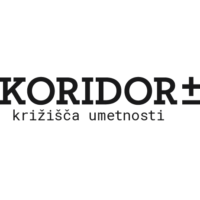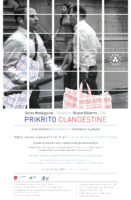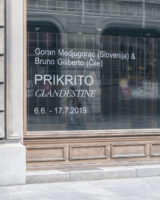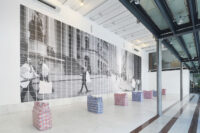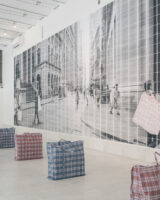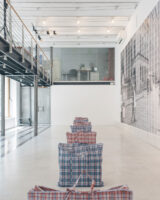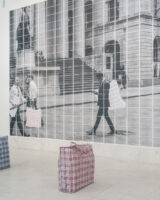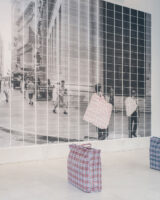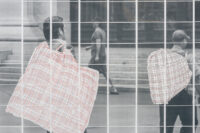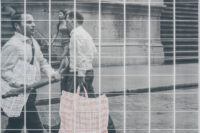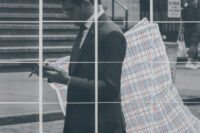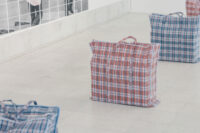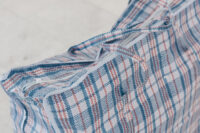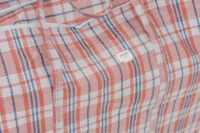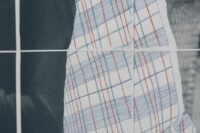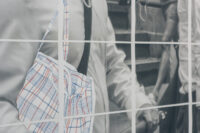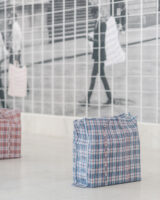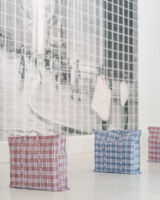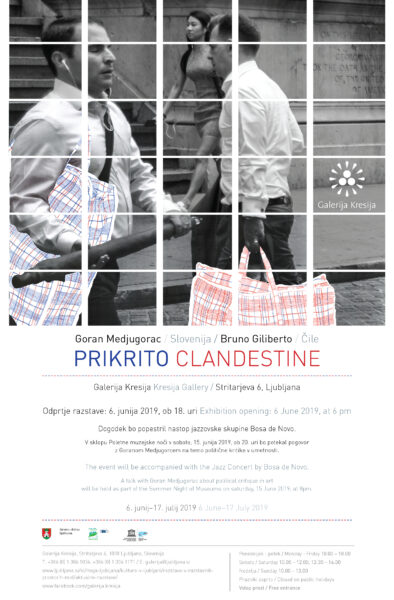
Solo Exhibiton
After being fellows at the University of Barcelona, where they studied for a master’s degree in visual arts, production and artistic research, architect and photographer Bruno Giliberto (1981) from Santiago de Chile and painter Goran Medjugorac (1972) from Ljubljana have extended their scholarly camaraderie into a collaboration for the exhibition Prikrito/Clandestine.
Is merging artistic expressions through a blown-up 12 by 4 metre photograph composed of photocopies, where Bruno’s architecturally and photographically methodical technological approach provides the basis for Goran’s artistic intervention that paraphrases the photographic model, merely a way of solving artistic and compositional challenges and reconcile the duality of their artistic approaches? This, indeed, could be the starting position. “As a photographer I only take photos” and “as a painter I am only interested in painting”. And yet in terms of subject matter, the work is much more subversive. One should not forget that back in 2008, two weeks before the bursting of the U.S. housing bubble was official, Goran Medjugorac had harbingered the event with his exhibition Izselitev/Eviction in the Cabinet, an exhibition lab set up by the Domestic Research Society in the courtyard of the Škuc Gallery in Ljubljana, by giving a first-hand account of the time when working as a locksmith in London, he witnessed the paradoxical eviction of tenants defaulting on their mortgages. Medjugorac predicted that the crisis would hit the most socially vulnerable and taxpayers worldwide, who paid for the sins of financial gamblers with the blessing of elected politicians.
Using precise framing, Bruno Giliberto Rodríguez’ photograph shows the intersection of the two key streets of Lower Manhattan, NYC. From the junction with Broad Street, the view goes down Wall Street all the way to the very core of the American liberal capitalism, which is home to the mighty institutions of the “American dream”: the New York Stock Exchange; Federal Hall – the birthplace of the first U.S. government, guarded by the statue of George Washington, the first U. S. President; The House of Morgan – the banking fortress of one of the most dominant American industrialist; and The Trump Building – the commercial and residential centre of the current U.S. President and author of the ‘America First’ policy. Wall Street, “the beating heat of the world’s financial system”, as the information signs there say, has been under close surveillance accompanied by strict security measures such as fences and checkpoints ever since the 2011 protests of the Occupy Wall Street movement against the corruption-induced collapse. As such, the street is mainly used by businesspeople working for the above mentioned mega-institutions of the modern religion called “Money rules the world”, who still, literally, carry laptops with financial documents in their suitcases and backpacks from meeting to meeting, peevishly zigzagging the streets to avoid the meek tourists who have arrived in the financial mecca to satisfy their curiosity.
The artists intervened with this frozen image by erasing the designer suitcases, backpacks and bags on the black-and-white photograph, composed of 720 A4 sheets, replacing them with the so-called red-white-blue bags. Made of nylon canvas, these cheap, durable bags flooded the world thanks to hyper-production, practicality, and global accessibility, becoming synonymous with economic and political migration and cheapjack bargain. The full-wall grid of the photograph photocopied on 720 sheets of A4 paper is complemented by an installation consisting of packed red-white-blue bags placed in space in the repetitive manned of Donald Judd’s sculptures. Where does the red-white-blue bag come from? First produced in the 1950s, the bag originates in Japan, where nylon canvas for protective coverings or bags was invented. The original bag was blue only, similar to the one that can now be bought from IKEA. Through trade, it arrived through Taiwan to Hong Kong, and in the 1960s to China, from where it is largely exported today. The minimum order is 10,000 pieces. Known as “the Chinese bag” in Slovenia and “the Turkish suitcase” (Türkenkoffer) in Germany, the bag was dubbed “Ghana Must Go” in Africa after two million Ghanaian immigrants without proper documents had to pack all their belongings and leave Nigeria overnight following an executive order in 1983. The bag gained its signature red-white-blue stripes in Hong Kong. “The armoured bag” as it is also called there thanks to its sturdiness, was commonly used by Chinese workers who kept migrating from Hong Kong to mainland China and back, carrying with them all sorts of smuggled goods. As a result of the persistence of its global omnipresence and profusion, the durable bag – with hopeless zippers that earned it the pejorative label of “Chinese quality”– inevitably grew into an artistic phenomenon and a high fashion item. At the 2005 Venice Biennale, Stanley Wong used the bag as the leitmotif of the Hong Kong pavilion, while Louis Vuitton used it in his fashion line, claiming that the colours represent the flag of France. The duality of the perception of its symbolic meaning depending on the social class is also evident from the fact that the users of luxury fashion LV bags and the signature chequered pattern in red, white and blue only rarely understand the symbolic meaning and implication of the red-white-blue bag as the sign of economic and social disadvantage of those who use it daily for its cheap and practical nature. It was this gap between the two worlds that artists Bruno Giliberto Rodríguez and Goran Medjugorac used to account for the symbiosis of cheapness and sophisticated taste, suggesting the transfer of the flea market bargaining strategy to the highest-level global finance. While any collapse of the latter concerns everybody who is part of the world’s financial structure, the profits are collected by very few. The short-sighted financial gamble of the chosen elites as a way to make quick profits and their financial bubbles created on the shoulders of the most vulnerable and underprivileged create tensions and mass migration. On the backs of migrants, hastily packed red-white-blue bags set out for a “better” world concocted by dealers selling the dream of abundance and bogus opportunities. The symbolism of the duality is reflected in the strategies adopted by the world’s two largest economies: the hyper-production of the Chinese industry and trade as opposed to the Wall Street’s global financial speculation, an instrument too conformist to easily give up. The desire for increased profits has inevitably turned the luxury designer suitcase of a sleek yuppie into the cheapjack bag of a haggler, thus becoming a symbol of modern business. The financial rapaciousness and loss of business credibility of financial gurus and global investment giants evoke the thought of the next economic collapse, and the fear that comes with it. What will happen in the aftermath of the exhibition Prikrito/Clandestine, which opens on 6 June 2019, remains to be seen, for Goran Medjugorac is an artist whose wealth of life experience has honed his intuition to anticipate change. He has a talent for picking very strong artistic collaborators, such as Bruno Giliberto Rodríguez now, complementing them and effectively responding to the social climate by pointing to the obvious that, in the desire to conform, all too often remains grossly overlooked.
